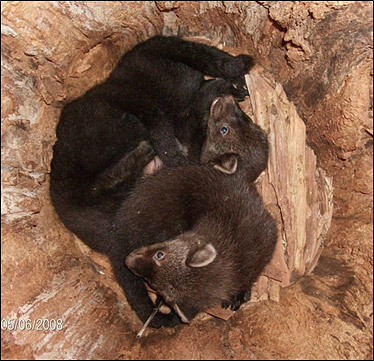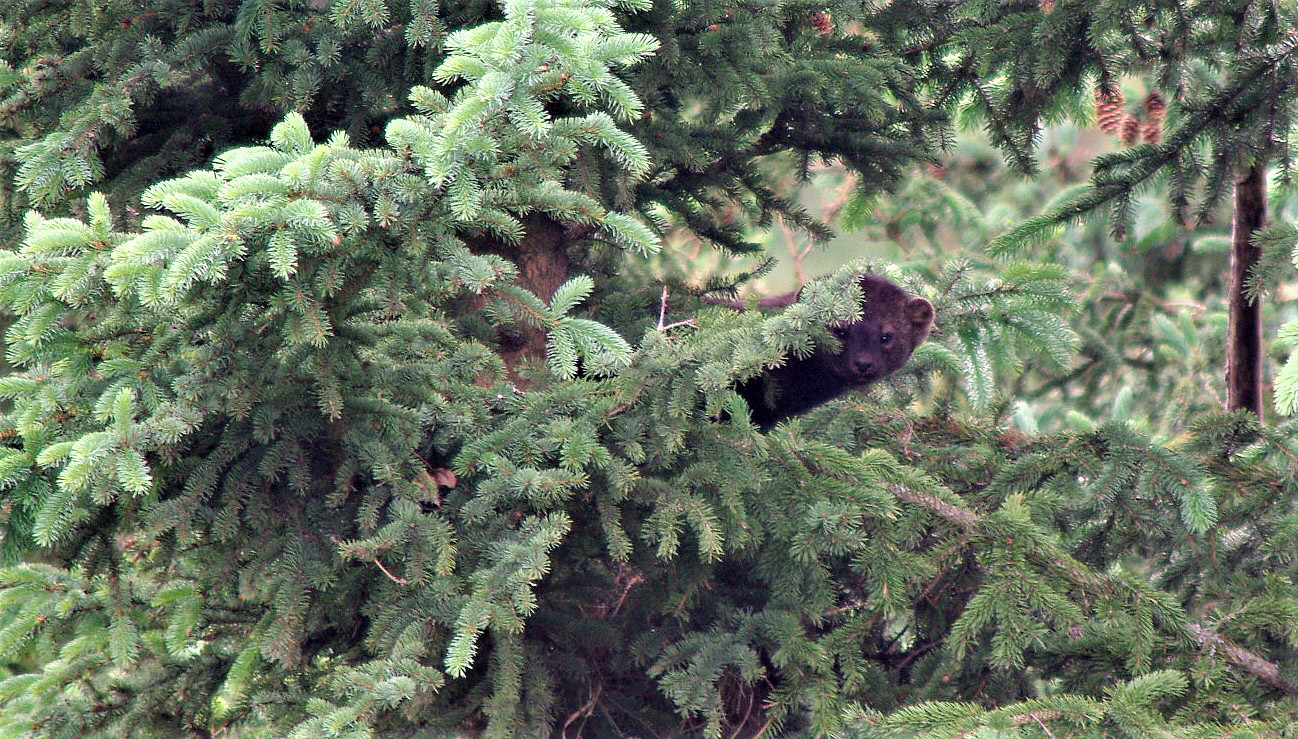By J. Scott Yaeger, MSc, RPBio with contributions from Rich Weir, MSc, RPBio
This article originally appeared in the September/October edition of BC Forest Professional Magazine (republished with permission).
Pungent vanilla. Two words that I wrote in my field notebook twenty-four years ago to describe the subtle aroma on my hands after handling my first fisher (Pekania pennanti). Even now, those two words bring back the vivid memory of the day I caught this beautiful and elusive predator to attach a radio transmitter as part of a research study to learn more about how fishers use their forested habitats.
This housecat-sized member of the weasel family is difficult to study because they’re rarely seen by people, even those who work daily within the forests they inhabit. In fact, there are fewer fishers (less than 2,8001) than grizzly bears (about 17,0002) in British Columbia — and grizzly bear sightings don’t happen all that often. You might never see a fisher, but you are soon likely to hear more about this species because they’re becoming rarer in British Columbia. Research indicates that in areas where habitat is modified faster than it can re-grow, the ability of these landscapes to be occupied by fishers is “gravely” affected.3
Forestry professionals may soon be under increasing pressure to incorporate this rare animal’s needs into their forest development plans since fishers have specific habitat requirements (see Fisher Habitat 101 below). Because fishers have an association with late-successional forests, they’re sometimes perceived to be at odds with forestry objectives. It is true that timber harvest can dramatically impact the ability of the forest landscape to support fishers. But it doesn’t have to!
With financial support from the Habitat Conservation Trust Foundation, the Forest Enhancement Society of British Columbia, and the Fish and Wildlife Compensation Program – Peace, the BC Fisher Habitat Working Group works closely with forest industry partners to develop stewardship tools meant to help forest professionals include fisher habitat essentials into their forest development. Using data from 25 years of on-the-ground research, these tools help identify fisher habitat and provide specific guidance to support forest management decision-making.
As an example, GIS planning tools are available throughout the range of fishers to help planning foresters evaluate fisher habitat condition surrounding a proposed cutblock and provide detailed retention target recommendations for site-planning considerations. At a smaller scale, being able to identify fisher habitat on-the-ground (a single reproductive den tree for example) is crucial to reduce longer-term impacts of harvest operations. To this end, fine-scale tools (such as photo guides) are available to identify specific fisher habitats for retention and even how to build important habitat features within cutblocks.

Fisher kits in a den. Fisher dens need to be a minimum of 30 cm in internal diameter. Photo credit: Inge-Jean Hansen
How can forest professionals, or anyone interested in fisher habitat, get their hands on these tools to help inform decisions regarding fisher habitat stewardship? Visit the BC Fisher Habitat and Forestry Web Module where job-specific tools are available for forest industry personnel form planners to feller-bunchers. There’s also a helpful six-minute video that provides an overview of what’s available.
These tools help make it easier for forest professionals to include fisher habitat considerations into forest development projects. For more info and to request support for your specific operational requirements or to schedule one of the free training sessions regularly offered to forestry operations throughout the range of fishers in BC, please get in touch with Scott Yaeger or Rich Weir.
With your help, we can build approaches that work for both forestry and fishers and curb the decline of this species in British Columbia. By adopting these voluntary measures, you may be able to reduce the risk of additional regulatory requirement if BC fishers were to become federally listed. Please take a few moments of your time to visit the website, try out our tools, and get in touch with your ideas on how we can help you incorporate fisher habitat needs into your operations.
Fisher Habitat 101Fishers require specific forested habitats from individual trees to landscapes to fulfill their life requisites — namely reproductive denning, resting, foraging, and movement habitats. A good fisher home range (25 to 50 km² for females and much larger for males), includes a balanced mixture of forest ages and conditions that supply overhead cover, ample hunting opportunities, and large structures scattered throughout.Large-diameter live trees that are old, rotting, and deformed provide secure denning and resting locations that fishers need to survive and reproduce. Fishers are the largest animal in British Columbia that requires a tree cavity for successful reproduction, and big cavities — with a minimum of 30 cm internal diameter — are needed to house a mother and her two or three kits (photo). The trees that meet these conditions are generally old (more than 100 years) and large (greater than 40 cm dbh).Foraging habitat for fishers can be found in a variety of forest stands, including young forests if security cover is present. Fishers also require movement habitat to safely travel between important areas within their home range and to access new areas when dispersing. Movement habitat is supplied by dense tree and shrub cover, which provides protection from above and vertical escape opportunities.
Fun Fisher Facts:
Uncharacteristic of their name, fish are not a regular prey item for fishers. Fishers will eat anything they can catch, but primarily prey on snowshoe hares, squirrels, birds, and mice.Fishers are one of very few predators that actively seek out and prey upon porcupine. While most animals avoid porcupines due to their quills, fishers are quick enough to avoid the quills, nipping the porcupine in the face, and keep at it until the porcupine succumbs.Fishers are able to rotate their hind legs 180 degrees and climb down trees headfirst (a useful skill when pursuing a squirrel!)
REFERENCES
- Weir, R. D. 2003. Status of the fisher in British Columbia. Ministry of Sustainable Resource Management, Conservation Data Centre, and Ministry of Water, Land and Air Protection, Biodiversity Branch, Wildlife Bulletin Number B-105. Victoria, British Columbia.
- Hamilton, A.N., D.C. Heard, and M.A. Austin. 2004. British Columbia Grizzly Bear (Ursus arctos) Population Estimate. B.C. Ministry of Water, Land and Air Protection, Victoria, BC. 7pp.
- Weir, R. D., and F. B. Corbould. 2010. Factors affecting landscape occupancy by fishers in north-central British Columbia. Journal of Wildlife Management 74:405-410.






